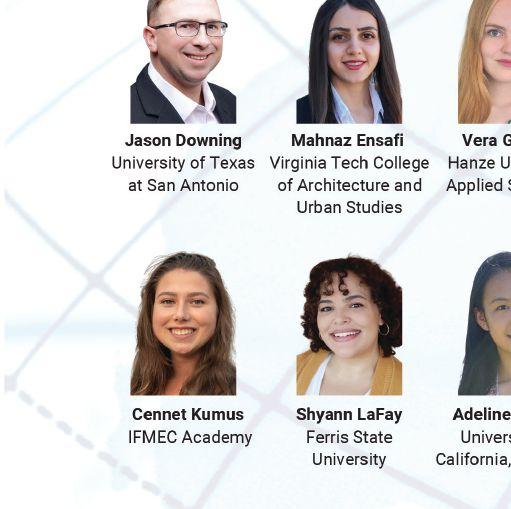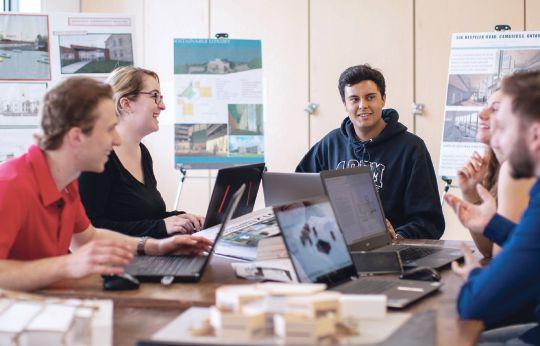
18 minute read
Behind the Brand
COMPANY NAME: Tork, an Essity brand EXPERTISE: Sustainable Hygiene Management CSP LEVEL: Silver WEBSITE: torkusa.com
Who is Tork?
Advertisement
Tork is the Professional Hygiene brand from Essity, a leading global hygiene and health company. The Tork brand off ers professional hygiene products and services to customers worldwide, ranging from restaurants and healthcare facilities to offi ces, schools, and industrial facilities. Our products include dispensers, paper towels, toilet tissue, soap, napkins, wipers, but beyond physical cleaning products, we off er software solutions for datadriven cleaning. Through expertise in hygiene, functional design, and sustainability, Tork has become a market leader that truly supports customers and inspires them to think ahead so that they are always ready for business. Tork is a global brand of Essity, and a committed partner to customers in over 110 countries. To keep up with the latest Tork news and innovations, please visit www.torkusa.com.
What does “Sustainable Hygiene Management” mean?
Tork defi nes sustainable hygiene management as the practice of fully integrating products and services into customer processes and procedures to achieve the hygiene standards appropriate for the given environment, or a person within that environment, in a sustainable way. While there has been a heightened awareness of hygiene practices due to the global pandemic, sustainability also remains top of mind for employers and employees. Eff ective hygiene management and sustainability measures are frequently seen as separate necessities to meet rising visitor/employee expectations, but sustainable hygiene management can improve business performance within both areas in a seamless, effi cient manner. Facility managers do not need to choose between addressing visitor/employee demands and meeting business needs — they can satisfy them both when partnering with Tork. Tork brings the expertise needed to improve business effi ciency, workfl ows, staff well-being, and guest experience — all while supporting sustainability eff orts. To learn more how Tork has implemented sustainability practices visit: www.torkusa.com/sustainability/ world-leader/sustainability.
COMPANY NAME: Armstrong Ceiling Solutions EXPERTISE: Ceiling and wall solutions CSP LEVEL: Silver WEBSITE: armstrongceilings.com/commercial
Tell us your “why” in the FM world.
Facility managers are looking for ways to improve offi ces, retail environments and other commercial buildings for occupant health, safety and productivity. Armstrong Ceiling Solutions, has been in business for over 160 years, and we believe a healthier space starts at the top — with the ceiling. The ceiling pulls together core elements of a healthy space — air quality and ventilation, lighting, acoustics, sustainability, and design. Building on our legacy of leading-edge product design and materials science, the Armstrong sustainable ceiling and wall portfolio includes solutions to enhance air quality, acoustics, natural light refl ectance, all customizable in performance and design confi guration.
What’s on the horizon in your fi eld/industry, and how is Armstrong meeting those challenges and opportunities?
With the renewed focus and importance placed on indoor environmental quality, Armstrong Ceiling Solutions is producing ceiling and wall solutions that “clean, contain and protect” by improving indoor air quality, acoustics, and natural and supplemental lighting. The Armstrong 24/7 Defend™ portfolio includes AirAssure™ ceilings and VidaShield UV24™ air purifi cation systems to maintain and improve indoor air quality. The portfolio also features CleanAssure performance, Total Acoustics™ ceilings to provide the best combination of sound-absorbing and sound blocking properties, and ceilings from the Sustain® portfolio that meet the highest industry sustainability standards today.
Tell us about your corporate social responsibility and environmental, social and governance eff orts or projects.
Armstrong was the fi rst to institute a ceiling recycling program and was a founding member of the U.S. Green Building Council in 1993. Armstrong continues the commitment to sustainability and healthy buildings through a new partnership with 9 Foundations, Inc. consisting of leading scientifi c experts on the connections between human health and built environments, bringing unmatched technical knowledge and experience to the most critical public health challenges of our time. With this partnership, 9F will work with Armstrong in its continued focus on manufacturing ceiling and wall solutions based on the most advanced healthy building science and design.








WHAT COURSES ARE OFFERED?
COURSE CODE COURSE TITLE AND DESCRIPTION
1st year Level 1 — FALL
ARCH71120 Construction Materials and Methods I ARCH71140 Introduction to Architecture — Project and Facility Management ARCH72010 Building Sciences COMP71180 Computer Concepts I DSGN71055 Studio I ENGL71000 Academic Communications as of the fall 2020 FND71055 Foundation Module (Architecture) SOC71500 Group Dynamics
Level 2 — WINTER
ARCH71010 Human Health, Ergonomics, Environment and Safety ARCH71130 Construction Materials and Methods II (PreReq Construction Materials & Methods I) ARCH71150 Code I COMP71190 Computer Concepts II DSGN71010 HVAC and Fire Protection DSGN71060 Studio II (PreReq Studio 1)
SUMMER — off
2nd year Level 3 — FALL
ARCH72110 Construction Cost Estimating ARCH73010 Code II (PreReq Code I) CEPR71050 Co-op and Career Preparation DSGN72000 Structural Systems DSGN72015 Building HVAC Equipment (PreReq HVAC & Fire Protection) DSGN72110 Studio III (PreReq Studio II) DSGN73010 Energy and Design (PreReq Academic Communications)
Level 4 — WINTER
ARCH72030 Building Performance ARCH73140 Construction Specification Writing DSGN72120 Studio IV (PreReq Studio III) FIN72050 Business Economics HIST74100 History of Advanced Structures
Electives: Interdisciplinary 3rd year Level 5 — SUMMER
COOP72010 Co-op Work Term I (APFM)
Level 6 — FALL
ARCH73020 Property Management (PreReq Building Performance) ARCH73120 Development Economics ARCH73130 Construction Planning and Scheduling DSGN72025 Building Plumbing, Lighting & Electrical Systems (PreReq HVAC and Fire Protection) DSGN73110 Studio V (PreReq Studio IV) RSCH73000 Understanding Research
Level 7 — WINTER
COOP73010 Co-op Work Term II (APFM)
Level 8 — SUMMER
ACCT74100 Financial and Managerial Accounting ARCH73080 Project Leadership ARCH74030 Utilities Management (PreReq Building Plumbing, Lighting & Electrical Systems) ENGG74100 Value Engineering and Life Cycle Costing DSGN74010 Studio VI (PreReq Studio V) STAT73100 Applied Statistics (PreReq Understanding Research)
4th year Level 9 — FALL
COOP73020 Co-op Work Term III (Architecture - Project and Facility Management)
Level 10 — WINTER
ARCH74040 Facility Operations and Maintenance ARCH74060 Advanced Building Performance and Automation ARCH74110 Construction Quality Management ARCH74120 Construction Risk Management DSGN74020 Studio VII (PreReq Studio VI) LAW74900 Law and Ethics
Level 11 — SUMMER
ARCH74020 Corporate Real Estate (PreReq Property Management) ARCH74090 Contract Administration CLTR74000 Heritage Conservation DSGN74030 Studio VIII (PreReq Studio VII) SOC74020 Urban and Community Planning
Electives: Interdisciplinary

WHAT KINDS OF RESEARCH IS YOUR DEPARTMENT CONDUCTING AND WHAT ARE YOU MOST EXCITED ABOUT? Research by students is a key area of the program. Students participate in both an individual and team research project. Individual research topics must be within the scope of the program and students are often influenced by their co-op industry experiences when selecting their topic. This allows for a great variety of topics in the breadth of FM studies and is very consistent with industry knowledge needs. Sustainability, viewed from a variety of aspects, is often selected as an individual project. The team effort is a capstone project which is built on research by student teams to develop a business case for student accommodation needs. The project is based on comparing current situations to the needs and demands of future students.

WHAT ARE THE ISSUES FACING THE NEXT GENERATION OF FMS AND HOW WILL THEY BE ADDRESSED? There are two key issues regarding FM education. The first is gaining a student’s attention to an industry which has a broad scope of skills needed in a variety of industries. It is sometimes difficult to explain to prospective students that they could be employed in numerous areas in many different business sectors. The second is getting industry to recognize the breadth of skills these graduates bring to the workplace. Higher level FM education is still lacking recognition. We believe industry gains experience through co-op education or hiring program graduates. Students who come out of these programs are work-ready. Another issue facing the industry is that FM graduates are not staying in the FM industry. As they gained experience, these professionals also gained greater opportunities. This speaks directly to the demand for highly transferable FM skills to a variety of business sectors.

Buildings are welcoming back a steady workforce and occupancy is increasing. As people return, they expect to feel as comfortable as they did at home. They expect that the air they breathe is safe and clean.
Major factors in providing a safe, comfortable work environment are the functionality and sustainability of the systems that heat and cool facilities, as well as keeping the air clean and fi ltered. These systems directly impact how successfully a building performs. Is it possible to work smarter, not just harder, managing the requirements of occupants? Yes. But not without the right tools and support.
Thanks to improved technology, the way buildings are monitored and maintained has improved. That is great for FMs, if they are keeping up with the available improvements. With some minor enhancements, it is possible to utilize existing building equipment to gain real insight into how the building is performing.
With the right tools and analytics, it is possible to improve equipment performance, reduce energy costs and increase occupancy comfort.
A typical building generates millions of data points every day. This data off ers incredibly useful information that can help FMs better understand their buildings. With facility analytics, data is collected from sensors on existing equipment systems to better diagnose malfunctions and faults and fi nd potential opportunities for improvements, including energy savings.
Light hardware or software is installed to facilitate communication between an existing building automation system (BAS) and off -site cloud servers. Many BAS manufacturers now build their products on open protocols and standards to allow owners this kind of fl exibility. Data from the building is transmitted to the cloud where it is compared against an ever-expanding set of algorithms to fi nd mechanical failures, programming problems or energy saving opportunities.
With advanced programs, the results of the diagnostics are summarized into a simple set of easily interpretable scores for the building and its equipment so that long-term progress or degradation can be easily visualized and understood by key stakeholders. Meanwhile, individual faults and opportunities, interpreted by experts, are shared with FMs alongside potential remedies.

CLOUD
TELEMETRY
DIAGNOSIS REPORTING RESPONSE
Facility analytics can be used to better diagnose malfunctions and faults and fi nd potential opportunities for improvements, including energy savings.
Leveraging data analytics requires more than just software with an owner left to their own devices. To be most eff ective, specifi c expertise is required so that results can be deciphered and applied correctly. In the right hands, these tools allow a deeper understanding of a building’s operation and how to maximize performance. Working with data scientists, a skilled service technician can become an FM’s trusted partner who can utilize the innovation to deliver a higher quality of service, save clients money and headaches, and serve the changing needs of the building and its business.
When interpreted by BAS specialists and facility analytics engineers, data becomes information that can be used to develop a better operational plan for a building. It is about doing the things that a specifi c building requires to get to peak performance — not more, not less.
Traditionally, system maintenance plans fell into one of two categories. In one model, a new system is installed; when it breaks, service is called. Technicians may also change or clean a fi lter, but it is 100 percent reactive, and the onus is on the building occupants to notice any problems. A second approach is a more preventive plan, in which maintenance follows manufacturer guidelines, such as constantly changing fi lters, examining belts and cleaning coils at a certain time each year. A plan like this may include more labor and parts than a building needs, and eff ort may not be directed exactly where it is required. Technology puts a total view of building performance in the hands of both FMs and their service partners, enabling a more proactive and effi cient practice. By applying facility analytics, with no additional manpower, it is possible to see what is happening in every corner of a facility, 24 hours a day, seven days a week. A set of rules can then determine how well systems and components are performing. If certain patterns are known to lead to a component failure, that trend can be identifi ed early, and action can be taken to prevent a more costly fi x down the road. With sophisticated programs, tracking reports are used that allow FMs to see fi rsthand what is happening in their facilities. For instance, simple graphs can be used to show what equipment in the building is performing well, and which may require some expert attention. Knowing where to look at a glance, and armed with more specifi c fault information, a technician can arrive on site ready to go directly to a problem area and fi x it. This allows more time to address or search out other potential — and perhaps less obvious — problems or opportunities.
Looking at two extra things every visit to a job can really add up. Buildings do not break down all at once. Components fail one or two at a time over a long period. Performance degrades because FMs may not notice the many small problems that accumulate and weaken building performance. A facility partner with a total view of the building, who can fi x a few additional problems each visit, turns the tide in favor of a more performant, more comfortable building.
If a centralized set of analytics is used, rules can be constantly added and enhanced and capabilities perpetually grow, which





GO FLOW with the




Choosing the right airfl ow valves
BY AURI ANIULIS
Facility managers play an integral role in a building’s operational success. From overseeing security systems to tracking health and safety standards, FMs wear many hats. Of their responsibilities, the most demanding is maintaining what is often a building’s largest and most expensive asset — the heating, ventilation and air conditioning (HVAC) infrastructure.
HVAC systems serve two main purposes:
1. Maintaining occupant comfort through temperature and humidity control. 2. Creating safe and therapeutic environments for occupants by dispersing and mitigating the fl ow of airborne pathogens, dangerous fumes and toxic dusts within critical spaces such as patient isolation rooms and laboratories. This is achieved through specifi c standards around air changes per hour, fresh air changes, negative or positively pressured rooms, and temperature, humidity and CO2 management.
Managing large and complex HVAC systems can be especially challenging for facilities with various environments to supervise, as FMs must ensure compliance from regulatory bodies and balance control sequences with how people are utilizing the space in real time. However, it is easier to meet compliance, as well as achieve and maintain optimal HVAC performance, when using airfl ow control technology that is best suited for specifi c applications.
With so many valve options on the market, it can be diffi cult to determine the best fi t for a facility. There are three common types of airfl ow control valves that keep general use spaces and critical environments safe and comfortable: variable air volume (VAV) valves, measured airfl ow valves and Venturi air valves.
GENERAL USE SPACES: ACHIEVING A COMFORTABLE TEMPERATURE In noncritical environments such as offi ces, auditoriums, schools and shopping centers, VAV valves are recommended for both the general supply and exhaust. At the lowest price point, VAV valves have a simple blade-style damper, standard actuator speed, and control the volume of conditioned air to manage temperature, humidity and ventilation. The VAV valve is the most basic airfl ow valve on the market as its main purpose is to simply maintain a comfortable environment through general supply and exhaust.
However, throughout the COVID-19 pandemic, enhanced public health and safety within general use spaces became a top concern. As public health offi cials gained a better understanding of how
COVID-19 can be transmitted through airborne droplets, building owners and FMs looked to their HVAC system to help mitigate airborne transmission risks.
To create safer general use spaces, FM, architects and engineers borrowed airfl ow control concepts from stringent requirements usually reserved for critical environments, such as patient isolation rooms and laboratories. Techniques include:
• Increasing the outdoor air changes per hour to pump more fresh air into spaces to dilute and disperse aerosols • Increasing the air change per hour (ach) rate from 2-3 to 6 ach • Creating negative pressure zones • Utilizing UV-C light fi xtures • Adding plug-in room HEPA fi lters • Installing MERV-13 fi lters
HVAC professionals are also creating fl exible spaces for health care buildings and other facilities that allow for a higher standard of care when hospital patient rooms are at capacity. The design of these fl exible spaces includes installing Venturi air valves in general use spaces to be activated if needed. For example, a hospital might install Venturi air valves within an offi ce space to have the option to create additional negative pressure patient rooms with greater airfl ow control.
PATIENT ROOMS: MAINTAINING PRECISE TEMPERATURE, PRESSURE AND HUMIDITY CONTROL Health care settings demand agile and reliable control products to provide a safe and therapeutic environment for patients and staff . There are strict requirements for maintaining the proper temperature, air pressure, air changes and humidity for patient rooms. These parameters create healing and protective spaces, depending on the patient’s needs. To produce these specialized environments, Venturi air valves or measured airfl ow valves should be installed for the general supply and exhaust. Set at a higher price point, both specialty valve types use speed and precision to provide airfl ow changes to real-time room fl uctuations to continuously disperse and mitigate dangerous aerosols. However, both valves have their unique design elements.
Venturi air valves are pressure independent and are specifi cally designed to provide accurate and repeatable control. They have a high turndown ratio and utilize a cone and spring assembly to maintain desired airfl ow regardless of duct pressure changes. Venturi air valves also utilize fast-acting actuators that provide a rapid response to changing conditions. This rapid response ensures the airfl ow is constantly maintained at desired levels, which is essential in health care settings. Multiple Venturi air valves can also be used together to increase the supply or exhaust airfl ow.
Measured airfl ow valves provide an airfl ow sensing technology and are pressure dependent. They successfully operate with lower diff erential pressures compared to Venturi air valves. Measured airfl ow valves also have a high turndown ratio but sensor drift is a consideration to manage. They can be used in tandem with Venturi air valves to increase airfl ow management capabilities.
LABORATORIES: STABILIZING AIRFLOW VOLUME AND ENERGY CONSUMPTION
Similar to patient rooms, laboratories require more advanced HVAC controls over simple VAV valves to ensure dangerous aerosols do not travel throughout a space. Venturi air valves or measured airfl ow valves can both be used for the general supply and exhaust because of their speed and accuracy in maintaining airfl ow during dynamic room conditions.
Laboratories also often contain multiple fume hoods, which greatly aff ect the air balance of a space. Although both airfl ow valves can be used alone or in tandem for general supply and exhaust, corrosive-resistant coated Venturi air valves are best suited for fume hood exhaust ducts. This is because the valve has no sensors and FMs do not have to worry about chemical erosion or debris buildup to receive accurate airfl ow information from the fume hood controller. Venturi air valves are also available with thermal insulation to prevent heat loss and increase energy effi ciency. Their faster speed of response over measured airfl ow valves and VAV valves is important for real-time airfl ow monitoring while someone is working in a fume hood.
Proper laboratory ventilation and fume hood exhaust management is a vital part of ensuring occupant safety, quality research results and regulatory compliance.
Energy effi ciency is also an important consideration when managing laboratory HVAC systems, as they are often the largest energy consumer within a campus or facility. Using outdated and ineffi cient equipment can cause unnecessary burdens on the infrastructure. Basic VAV valves cannot meet the stringent HVAC performance demands so it is best to avoid them within laboratory settings.





